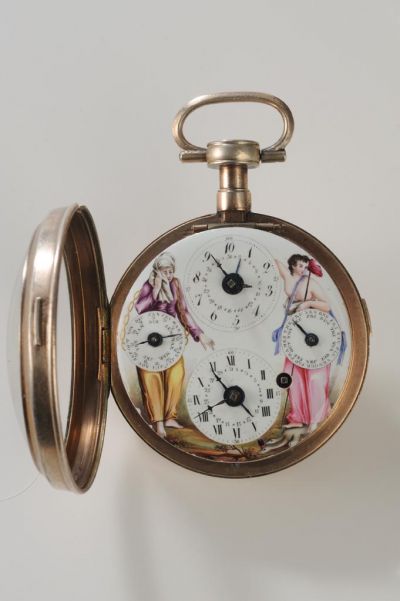
Pocket watch - with dial plate according to the French revolutionary and the Georgian calendar
| Accession Nr.: | 53.88.1 |
|---|---|
| Artist/Maker: |
Breguet, Abraham-Louis (1747 - 1823) |
| Date of production: |
late 19th century
ca. 1795
|
| Place of production: | Paris; |
The great turning point of the 18th century, the French Revolution, also brought about changes for clockmakers. A new French revolutionary calendar was introduced as was a decimal numerical system to simplify the keeping of time. A number of special pocket watches were made that indicated time not only according to the traditional system but according to the decimal system, too. As the decimal system was only used in France – and only for 13 years – such clocks and watches are today quite rare (some examples are at the Musee Carnavalet, Paris). The watch in the clock collection of the Museum of Applied Arts was made using this dual system, and indicates not only the hours, but also the days and months. Its escapement is provided with spindles, and there are four smaller dials on its round, white-enamelled dial plate. In the centre, placed one on top of the other, are two dials with the hours indicated 1–10 and I–XII, while on the two sides further dials indicate the days and the months, the traditional names on the left and the French revolutionary ones on the right. The dial with traditional names is hanging on a chain from the neck of a crying woman, while the revolutionary one is held by a blue ribbon on the shoulder of a young girl. The two female figures, painted in enamel, are symbolic. Next to the new calendar we see the well-known allegorical figure of the revolution – known as Marianne – dressed in the colours of the French tricolour and a Phrygian hat. She is stepping on a many-headed monster wearing a crown and bishop’s mitre. The crying woman next to the traditional dial represents the Ancien Regime, with the chains of bondage. The clockwork bears the mark of the workshop belonging to one of the most outstanding clockmakers of the period, Abraham Louis Breguet (1747–1823).
Literature
- Szerk.: Horváth Hilda, Szilágyi András: Remekművek az Iparművészeti Múzeum gyűjteményéből. (Kézirat). Iparművészeti Múzeum, Budapest, 2010. - Nr. 98. (Békési Éva)
- Békési Éva: Az idő hangja. Különleges óraszerkezetek. Iparművészeti Múzeum, Budapest, 2002. - p. 109.
- szerző: Prékopa Ágnes: Európai zománcművesség a középkortól a szecesszióig. Válogatás az Iparművészeti Múzeum gyűjteményeiből. Iparművészeti Múzeum, Budapest, 1991. - Nr. 40.




